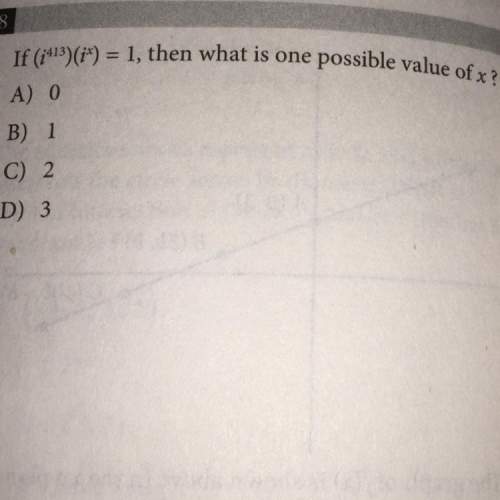
Mathematics, 15.12.2020 05:40 blackboy21
Which expression is equivalent to (1/2(cos(pi/5)+ i sin(pi/5)))^5
a. 1/32(cos(pi/5) + i sin (pi/5))
b. 1/32(cos(pi) + i sin (pi))
C. 1/10(cos(pi/5) + i sin (pi/5))
d. 1/10(cos(pi) + i sin (pi))

Answers: 2


Other questions on the subject: Mathematics

Mathematics, 21.06.2019 15:30, 30352
Hurry and answer this! circle x with a radius of 6 units and circle y with a radius of 2 units are shown which steps would prove the circles similar? translate the circles so they share a common center point, and dilate circle y by a scale factor of 4. translate the circles so the center of one circle rests on the edge of the other circle, and dilate circle y by a scale factor of 4. translate the circles so they share a common center point, and dilate circle y by a scale factor of 3. translate the circles so the center of one circle rests on the edge of the other circle, and dilate circle y by a scale factor of 3
Answers: 1

Mathematics, 21.06.2019 19:30, apere655
Ascientist wants to use a model to present the results of his detailed scientific investigation. why would a model be useful? a )because the model makes the concepts easier to understand b) because the model is easy to put together and to use c) because the model prevents other scientists from asking questions d) because the model requires the audience to pay full attention to it i don't know what to choose because between a and d a is much more likely than d because it only wants to get the attention of the audience. i'm confuse.
Answers: 1

Mathematics, 21.06.2019 22:10, oijhpl5085
Using graph paper, determine the line described by the given point and slope. click to show the correct graph below.(0, 0) and 2/3
Answers: 2

Mathematics, 22.06.2019 01:00, armonilucky11
Suppose m: angle a =77 degrees what is the measure of a complement of a complement of angle a, what is a conclusion you can draw about a complement of a complement of an angle
Answers: 1
You know the right answer?
Which expression is equivalent to (1/2(cos(pi/5)+ i sin(pi/5)))^5
a. 1/32(cos(pi/5) + i sin (pi/5))...
Questions in other subjects:

Mathematics, 03.04.2021 21:30

Mathematics, 03.04.2021 21:30





Mathematics, 03.04.2021 21:30

English, 03.04.2021 21:30






